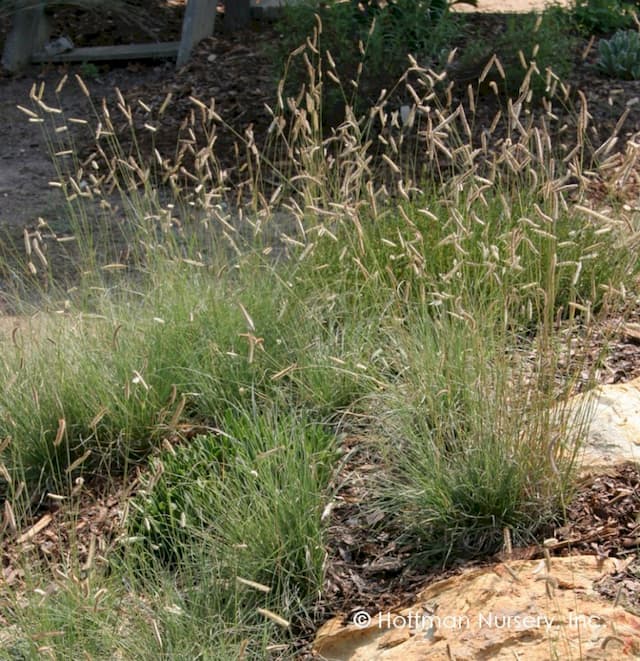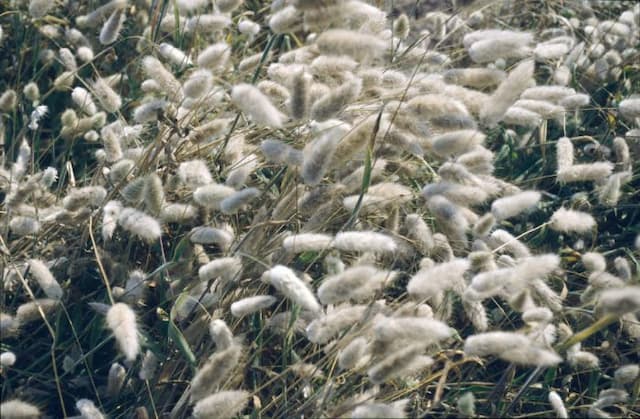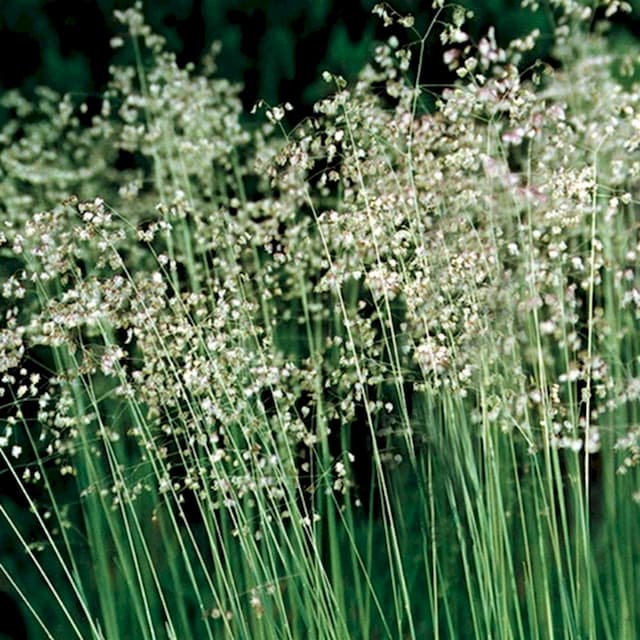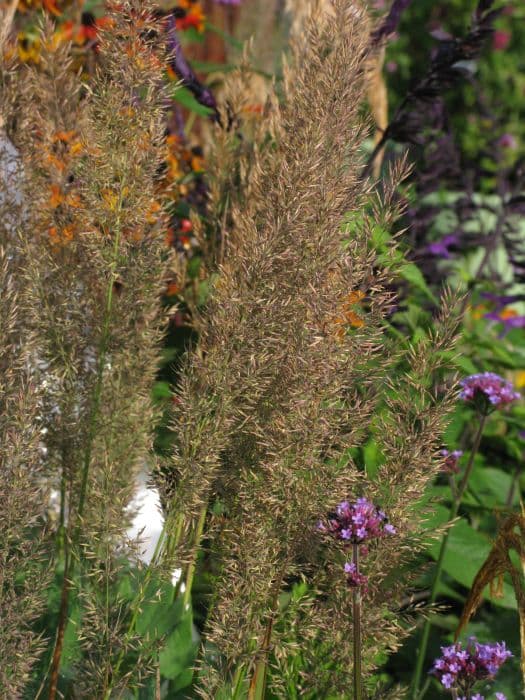Maiden Grass Miscanthus sinensis 'Roland'











ABOUT
The Miscanthus sinensis 'Roland', commonly known as Maiden grass, features a graceful and arching form that brings elegance and movement to a garden setting. This ornamental grass has narrow, ribbon-like leaves that are green with a silver midrib running through the center. The foliage tends to turn a lovely reddish-bronze or gold in the fall, providing seasonal interest. As the seasons progress, the Maiden grass produces feathery plumes that are held above the foliage on tall stalks. These plumes start with a reddish-tinge before transitioning to a soft silver or white as they mature, giving a dramatic and airy effect. When the sunlight catches these plumes, they can create a striking visual display, shimmering and swaying with the wind. The overall texture of 'Roland' Maiden grass is one of fine foliage and fluffy flower heads, which can add both softness and a vertical element to landscape designs. The plant has a clumping habit, which means it grows in bunches, making it suitable for use as a screen or as part of a mixed border. Additionally, it is valued for its year-round interest, from the green leaves in spring and summer to the warm autumn tones and finally to the straw-colored winter silhouette when the grasses are left uncut.
About this plant
 Names
NamesFamily
Poaceae.
Synonyms
Chinese Silver Grass, Maiden Grass, Eulalia, Japanese Silver Grass, Porcupine Grass.
Common names
Miscanthus sinensis 'Roland'.
 Toxicity
ToxicityTo humans
Miscanthus, specifically the Miscanthus sinensis 'Roland' cultivar, is generally not considered toxic to humans. There is no widespread documentation of toxicity following ingestion by humans, and it is typically grown as an ornamental grass without reports of significant adverse reactions upon contact or consumption. However, as with any plant material, individual allergies and sensitivities can vary, so it's advisable to exercise caution if you have a known allergic reaction to ornamental grasses.
To pets
Miscanthus, or Maiden Grass, is not known to be toxic to pets. This includes the 'Roland' variety of Miscanthus sinensis. The plant is commonly used in landscapes and gardens, and there are no significant reports of toxicity in domestic animals such as cats and dogs from ingestion of this grass. Nonetheless, it's still a good practice to monitor your pets around plants and to prevent them from ingesting large amounts of any non-food plant material, as it could potentially cause gastrointestinal upset or blockage.
 Characteristics
CharacteristicsLife cycle
Perennials
Foliage type
Deciduous
Color of leaves
Green
Flower color
Mixed
Height
6 feet (1.8 meters)
Spread
4 feet (1.2 meters)
Plant type
Grass
Hardiness zones
5
Native area
Asia
Benefits
 General Benefits
General Benefits- Ornamental Appeal: Adds aesthetic value to landscapes with its tall, elegant stature and feathery plumes.
- Low Maintenance: Requires minimal care once established, making it ideal for low-maintenance gardens.
- Drought Tolerance: Adapts well to dry conditions, reducing the need for regular watering.
- Soil Erosion Control: Its robust root system helps stabilize soil and prevent erosion.
- Long Season Interest: Retains visual interest from summer through winter with its persistent foliage and plumes.
- Habitat for Wildlife: Provides shelter and food for birds and other wildlife, enhancing biodiversity.
- Privacy Screen: Dense growth habit makes it useful as a natural privacy screen or windbreak.
- Versatility: Suitable for a variety of landscaping themes, from formal to naturalized areas.
 Medical Properties
Medical PropertiesThis plant is not used for medical purposes.
 Air-purifying Qualities
Air-purifying QualitiesThis plant is not specifically known for air purifying qualities.
 Other Uses
Other Uses- Miscanthus sinensis 'Roland', also known as Maiden grass, can be used in the production of paper and cardboard, offering a sustainable alternative raw material due to its high cellulose content.
- The fibers from Maiden grass can be utilized as a natural insulation material in construction, thanks to their thermal properties and biodegradability.
- Maiden grass is sometimes incorporated into musical instruments for its aesthetics, particularly in the crafting of wind instrument reeds and drumsticks.
- Dense plantings of Maiden grass can serve as a living snow fence, reducing snow drift on roads and highways during winter months.
- The tall, sturdy stems of Maiden grass can be used as natural stakes or supports for other plants in the garden, providing structure and support.
- Maiden grass can be crafted into brooms and brushes, using the strong foliage as bristles for homemade cleaning tools.
- In landscape design, Maiden grass is utilized in erosion control projects to stabilize soil and prevent the loss of topsoil due to water or wind.
- As a raw material, the grass can be processed into biodegradable pots for plants, which decompose and enrich the soil after transplanting.
- Maiden grass clippings can be used as a natural dye for fabrics, yielding colors that range from greens to browns depending on the mordant used.
- Bundled stalks of Maiden grass can create eco-friendly and biodegradable garden paths that blend into a natural landscape aesthetic.
Interesting Facts
 Feng Shui
Feng ShuiThe Maidenhair grass is not used in Feng Shui practice.
 Zodiac Sign Compitability
Zodiac Sign CompitabilityThe Maiden grass is not used in astrology practice.
 Plant Symbolism
Plant Symbolism- Adaptability: Miscanthus sinensis 'Roland', commonly known as Maiden Grass, is a versatile plant that adapts well to a variety of soil types and climates, symbolizing the ability to thrive in various conditions.
- Resilience: Maiden Grass demonstrates strong resilience as it can rebound from environmental stresses, representing the strength to overcome challenges.
- Growth: The way Maiden Grass grows tall and continuously each year can symbolize consistent growth and personal development in one's life.
- Privacy: Due to its dense growth habit, Maiden Grass is often used as a natural screen, offering a symbolic representation of privacy and seclusion.
- Grace: The flowing movement of Maiden Grass in the wind is reminiscent of elegance and grace, symbolizing a gentle and poised demeanor.
- Timelessness: As a perennial plant that returns year after year, Maiden Grass can symbolize enduring or everlasting concepts, such as everlasting love or friendship.
 Water
WaterMaiden Grass, also known as Miscanthus sinensis 'Roland', prefers consistent moisture but not overly wet soil. During the first growing season, water the plant deeply at least once a week, providing about 1.5 gallons per week to establish a deep, extensive root system. Once established, they can tolerate some drought and will require less frequent watering, roughly equivalent to 1 gallon every two weeks, depending on weather conditions. In the absence of rain or during particularly hot spells, you may need to water them every week. It's best to water this grass in the morning to allow leaves to dry out during the day, which helps prevent fungal diseases.
 Light
LightMaiden Grass thrives in full sun, meaning it requires at least 6 hours of direct sunlight each day to grow healthy and maintain its foliage's vibrant color. Ideally, it should be planted in a location where it has unobstructed access to sunshine throughout the day. Partial shade is tolerated, but too little light may cause the grass to grow less vigorously and not flower as profusely.
 Temperature
TemperatureMaiden Grass is hardy in a range of temperatures and can typically survive winter lows down to -20°F. The ideal growing conditions for Miscanthus sinensis 'Roland' fall between 55°F and 75°F. It will grow best when summer temperatures are warm but not excessively hot, and its foliage will stay healthiest when nighttime temperatures do not dip below 50°F.
 Pruning
PruningPrune Maiden Grass in late winter or early spring before new growth begins. This helps to maintain the plant's shape and encourages healthy new growth. Cut the foliage down to about 4 inches above ground level. Pruning annually will also remove any damaged or dead foliage and can prevent the center of the clump from dying out.
 Cleaning
CleaningAs needed
 Soil
SoilMaiden Grass (Miscanthus sinensis 'Roland') thrives in well-draining soil with a pH range of 5.5 to 7.5. A soil mix consisting of loamy garden soil, compost, and a bit of sand to enhance drainage works best. Mulching helps maintain moisture and regulates soil temperature.
 Repotting
RepottingMaiden Grass does not typically require frequent repotting as it is mostly grown in the landscape. If grown in containers, repotting can be done every 2 to 3 years to refresh soil and manage root growth.
 Humidity & Misting
Humidity & MistingMaiden Grass is not particularly sensitive to humidity levels; it tolerates a wide range of humidity conditions and is more concerned with proper soil moisture than atmospheric humidity.
 Suitable locations
Suitable locationsIndoor
Provide bright light and good air flow for Maiden Grass.
Outdoor
Plant in full sun and well-draining soil. Water regularly.
Hardiness zone
5-9 USDA
 Life cycle
Life cycleMiscanthus sinensis 'Roland', commonly known as Maiden Grass, begins its life as a seed that germinates in the spring, emerging as a small plant with thin, blade-like leaves. As it grows, the plant forms a dense clump with foliage reaching up to 6 to 8 feet in height, displaying feathery flowering panicles by late summer to early fall. These blooms can persist into winter, providing visual interest even after the plant has entered dormancy. The plant dies back to the ground with the onset of cold weather, but the roots remain alive and dormant through the winter. Once the temperatures increase in the spring, Maiden Grass resumes growth from the same root system, entering a new growth cycle. This perennial rhythm continues year after year, with the ability to spread and thicken overtime, potentially necessitating division after several years to maintain its vigor and shape.
 Propogation
PropogationPropogation time
Spring to Summer
Propogation: The most popular method of propagating Miscanthus sinensis 'Roland', commonly known as Maiden Grass, is through division. The ideal time to propagate Maiden Grass is in the early spring before new growth begins, or in late fall once the plant has gone dormant. To propagate by division, one should dig up an established clump of Maiden Grass and carefully separate it into smaller sections, ensuring that each section has a portion of the root system attached. These sections can then be replanted at the same depth they were originally growing, spaced approximately two to three feet apart to allow room for growth. It's essential to water the newly planted divisions deeply to help establish the root system. Regular watering should continue until the plant is well established. This method allows for the rapid increase of the plant while maintaining the characteristics of the 'Roland' cultivar.









